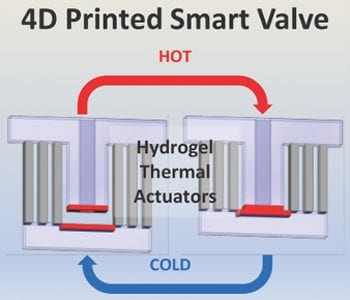An exciting example of 4D printing has been demonstrated by researchers at the University of Wollongong, Australia. By combining thermally active hydrogels and 3D printing, a temperature-responsive valve to control the flow of water is established.
An emerging technology, 4D printing combines smart actuating and sensing materials with additive manufacturing techniques (3D printing). Customized structuring of stimuli-responsive materials paves the path toward the next generation of smart sensors, robotics and self-assembling structures. In this recent investigation by G. Spinks and co-workers, selected for reprinting in the Best of Macromolecular Journals Edition 2016, 3D-printed hydrogel materials with fast and reversible linear actuation are incorporated into a smart valve.
Using a hybrid hydrogel with high toughness, resulting from combined ionically crosslinked and covalently crosslinked networks, mechanically robust thin sections can be prepared. The hydrogel, poly(N-isopropylacrylamide), is also thermally sensitive and contracts in volume when heated. The authors investigate the thermal actuation of a series of hydrogels with different ratios of covalent to ionic networks to assess their suitability in 4D printing applications. Reversible length changes up to 49% upon heating and cooling between 20 and 60 °C are observed. Importantly, mechanical tensile tests are conducted to consider the effect of loading on the actuation behavior.
The results of these tests prove promising, and are further highlighted through application of the hybrid hydrogel as a thermally activated smart valve. Composed of four components, each printed with a different material ink, the valve is printed in an open configuration. Upon contact with hot water, the actuators contract, closing the outlet and subsequently blocking the flow of water. Full details of the valve design and investigations of its reversible operation can be found in the manuscript, published in Macromolecular Rapid Communications.
The Best of Macromolecular Journals Edition 2016 is a special reprint issue highlighting the most impressive contributions from over one thousand articles published across the Macromolecular Journals family in 2015. All of these articles are free to access for one year. Find out more at www.best-of-macros.de.


















